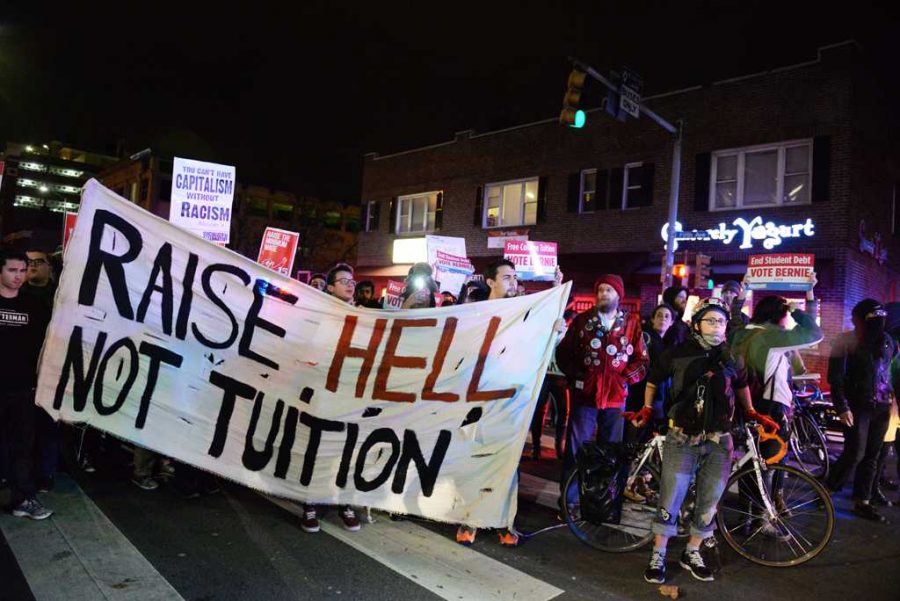When student rights are under attack, we all ought to stand up and fight back. And no other time in our life has this been more imperative than now — when the pursuit of a degree equates to mountains of debt.
Student debt is currently the second largest kind of debt in the United States, recently surpassing auto and credit card debt and falling below only housing debt, according to the Federal Reserve. College costs students around $30,000 a year.
The only way to curb this trend is by having the federal government switch its budgetary priorities — tuition must be free.
Free tuition will allow students to attain a college degree regardless of how much their parents make and without the burden of extreme debt. It is time to stop forcing students to pile on debt to gain a step up in life and time for the U.S. government to invest in students and our future.
Of course, not everyone agrees universally free tuition would be beneficial. In a Nov. 16, column featured in The Pitt News, Timothy Nerozzi discusses two notions regarding free public colleges tuition. The first was that making college tuition free makes colleges less competitive, and the second stating that those countries that do make public college free are making it worthless by diluting the market. Both are incorrect.
Not only are public universities where most U.S. students attend college, but 47 out of the top 100 schools are public schools, or were publicly funded at some point in time.
Looking specifically to Denmark, where workers are given new job training any time they are laid off or fired, we find the opposite of what this author says. These well-educated workers have not created a diluted market place where education, skill and training are so abundant that they are useless. Quite the contrary is true, actually.
Denmark, according to the Organisation for Economic Co-operation and Development, has a 5 percent poverty rate, the second lowest in the group. According to Forbes, Denmark is the best country for business — Forbes ranks the United States at 18th. At this point, the debate should not be over whether or not government funded education and skill training is good for economic and personal growth, but how the United States should go about implementing the program.
The best piece of evidence that tuition-free college is beneficial to a society comes from within our own borders. From the 19th century to the 1960s, every school in California was tuition free. There were student fees, like the housing fee or activities fee we pay at Pitt, but they clocked in between $50 and $200 per student, and schools offered cuts based on financial need.
When studying U.S. News and World Report college rankings, it’s hard not to notice that three of the top 20 colleges are in California. University of California, Los Angeles and University of California, Berkeley have only been around for 147 years. Until the 1960s, it was free to go to both of these schools. Berkeley and UCLA both compete well with private institutions in the U.S. World Report rankings, beating the likes of Georgetown, CMU and Wake Forest, who have been around much longer. Clearly, these schools being free for most of their histories came at no cost to their competitiveness.
Then, there is the question of how we will fund free tuition. Economic fear mongers would like you to think that we can’t afford tuition-free college. These alarmists would like you to think your taxes will rise sky high if college tuition becomes free, but most Americans’ taxes do not have to rise a single cent.
Since 2000, the United States has spent $300 billion on Pell Grants for students in need of financial aid to expensive universities. This fiscal year, U.S. taxpayers will spend $31.7 billion on Pell Grants. Students do not have to pay these grants back, and already we see this is $31.7 billion the U.S. government could put toward that free tuition at public institutions.
According to the plan proposed by Bernie Sanders, current Vermont senator and presidential candidate, tuition-free college would cost a mere $750 billion over 10 years, or $75 billion a year. If the grant money is moved away from subsidizing students who attend both public and private institutions, and is instead transferred to pay solely for tuition for public colleges, we would actually waste less money overall.
The government can then pay for a large portion of universal secondary education through Sanders’ proposed Wall Street speculation tax, which would pull in an estimated $30 billion. The plan aims to place the tax on stock trades at a rate of 0.1 percent, and trades of most derivative instruments at the rate of 0.01 percent, according to the Huffington Post. Another one of Sanders’ plans is to make the 1 percent pay their fair share in taxes — raising their rate to 45 percent would bring in another $276 billion.
We need to stop prioritizing the economic elites over the rights of students.
Now is the time to create a vibrant democracy and vibrant economy that no longer punishes hardworking students with debt, but allows them to get an education regardless of their income. We deserve free tuition. Our day has come.
Derek Jones, a sophomore history and anthropology major, was involved in the Million Student March protest and is involved in the Pitt Against Debt campaign.
Write to him at [email protected]


